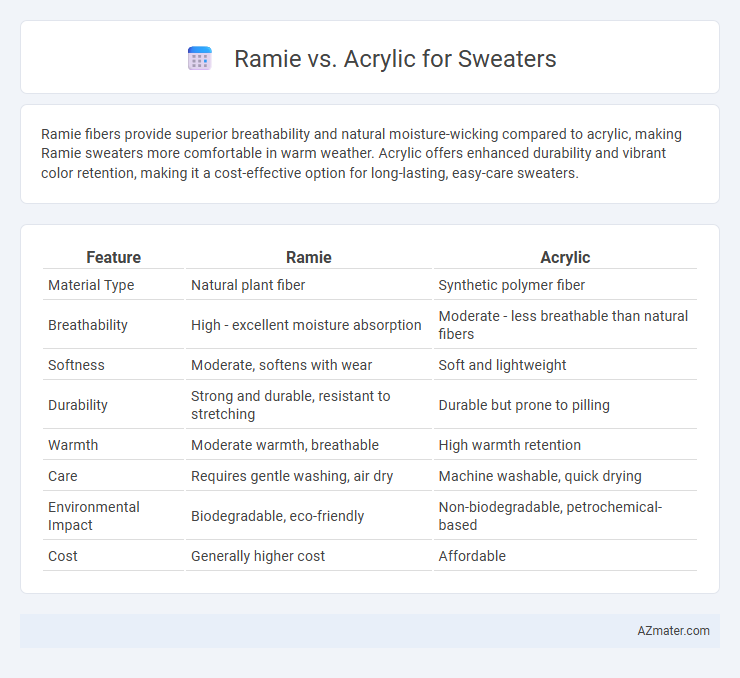Ramie fibers provide superior breathability and natural moisture-wicking compared to acrylic, making Ramie sweaters more comfortable in warm weather. Acrylic offers enhanced durability and vibrant color retention, making it a cost-effective option for long-lasting, easy-care sweaters.
Table of Comparison
| Feature | Ramie | Acrylic |
|---|---|---|
| Material Type | Natural plant fiber | Synthetic polymer fiber |
| Breathability | High - excellent moisture absorption | Moderate - less breathable than natural fibers |
| Softness | Moderate, softens with wear | Soft and lightweight |
| Durability | Strong and durable, resistant to stretching | Durable but prone to pilling |
| Warmth | Moderate warmth, breathable | High warmth retention |
| Care | Requires gentle washing, air dry | Machine washable, quick drying |
| Environmental Impact | Biodegradable, eco-friendly | Non-biodegradable, petrochemical-based |
| Cost | Generally higher cost | Affordable |
Introduction to Ramie and Acrylic Fibers
Ramie is a natural fiber derived from the stalks of the Chinese nettle plant, known for its breathability, durability, and silky texture, making it suitable for lightweight, eco-friendly sweaters. Acrylic is a synthetic fiber made from polymer compounds, prized for its affordability, vibrant color retention, and insulation properties, often used as a wool substitute in sweater manufacturing. When comparing the two, ramie offers better moisture-wicking and biodegradability, while acrylic provides greater elasticity and ease of care.
Origin and Production Processes
Ramie is a natural fiber derived from the stalks of the Chinese nettle plant, primarily cultivated in China and the Philippines, and involves a labor-intensive extraction process including harvesting, decortication, and degumming to remove lignin and pectin. Acrylic, a synthetic polymer fiber created through a chemical polymerization of acrylonitrile, is produced in industrial settings worldwide with a process that involves spinning the polymer into fibers using a solution or melt spinning method. The environmentally intensive production of acrylic contrasts with ramie's more ecological and traditional agricultural-based extraction.
Texture and Feel Compared
Ramie sweaters offer a naturally crisp texture with a smooth, linen-like feel that becomes softer with wear, making them breathable and ideal for warm weather. Acrylic sweaters provide a consistently soft, wool-like texture that is lightweight, warm, and resistant to wrinkles and moth damage. While ramie feels cool and slightly rough initially, acrylic delivers a plush, cozy comfort suitable for cooler climates.
Durability and Longevity
Ramie fibers exhibit superior durability and longevity due to their natural strength, resistance to abrasion, and ability to withstand frequent washing without significant wear. Acrylic, while offering good resilience and color retention, tends to pill and degrade faster over time with regular use. Choosing ramie for a sweater ensures prolonged fabric integrity and sustained aesthetic appeal, making it ideal for long-lasting garments.
Warmth and Insulation Properties
Ramie fibers provide moderate warmth with excellent breathability and moisture-wicking properties, making them suitable for lightweight sweaters in mild climates. Acrylic offers superior insulation, retaining heat effectively and mimicking wool's warmth, making it ideal for colder conditions. Sweaters made from acrylic are generally warmer and better suited for insulation compared to ramie-based garments.
Moisture Management and Breathability
Ramie fibers excel in moisture management due to their natural absorbency, allowing sweat to evaporate quickly and keeping the skin dry, which enhances overall comfort in sweaters. Acrylic, being a synthetic material, has lower breathability and traps heat and moisture, often causing discomfort during prolonged wear. Sweaters made from ramie are better suited for maintaining freshness and ventilation, making them ideal for warmer climates or active use.
Environmental Impact and Sustainability
Ramie fibers are natural, biodegradable, and require less water and pesticides compared to other crops, making them an eco-friendly choice for sustainable sweaters. Acrylic is a synthetic fiber derived from petrochemicals, which contributes to non-biodegradable waste and higher carbon emissions during production. Choosing ramie over acrylic supports lower environmental impact and promotes sustainable fashion practices.
Maintenance and Care Requirements
Ramie sweaters require gentle hand washing in cold water and air drying to prevent fiber damage and maintain fabric integrity. Acrylic sweaters are more durable and can typically be machine washed on a gentle cycle with cold water, drying flat to avoid deformation. Both fabrics benefit from avoiding high heat and harsh chemicals to extend the lifespan of the garment.
Cost and Affordability
Ramie sweaters generally cost more than acrylic due to the natural fiber's labor-intensive production and limited supply. Acrylic sweaters offer greater affordability and budget-friendly options, making them popular for everyday wear. Cost-conscious shoppers often choose acrylic for its lower price point without compromising on warmth and appearance.
Which is Best for Sweaters?
Ramie fibers offer superior breathability, natural luster, and durability, making them ideal for lightweight, breathable sweaters suited to warm climates. Acrylic provides excellent warmth, softness, and affordability, often mimicking wool's insulating properties, which is preferred for cozy, budget-friendly sweaters in cooler weather. Choosing between ramie and acrylic depends on desired sweater characteristics: natural comfort and moisture management favor ramie, while warmth and easy care prioritize acrylic.

Infographic: Ramie vs Acrylic for Sweater
 azmater.com
azmater.com